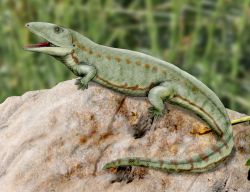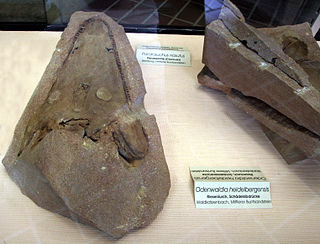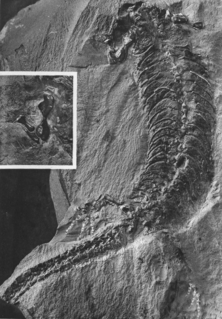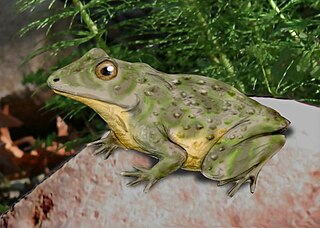 W
WBoii is an extinct genus of microsaur within the family Tuditanidae. It was found in Carboniferous coal from mines near the community of Kounov in the Czech Republic. Known only from a crushed skull, shoulder girdle bones, and scales, the known remains of this genus were very similar to those of Asaphestera, a more complete microsaur with a lizard-like appearance. However, this genus differs from Asaphestera due to its heavily sculptured skull, thin ventral plate of the clavicles, and a larger number of fangs on the roof of the mouth. For many years the type and only known species, Boii crassidens, was considered to be a species of Sparodus, until 1966 when Robert Carroll assigned it to its own genus.
 W
WDerwentia is an extinct genus of trematosaurian temnospondyl within the family Rhytidosteidae. It is known from a single skull found from the Knocklofty Sandstone of Tasmania, which is Early Triassic in age.
 W
WDutuitosaurus is a genus of metoposaurids, a group of amphibians that lived during the Late Triassic period. Dutuitosaurus was discovered in the early 1960s in Morocco and is known from the lower t5 units of the Timezgadiouine Formation exposures in the Argana Basin of the High Atlas Mountains and was first described in 1976 by French paleontologist Jean-Michel Dutuit. Material of Dutuitosaurus is currently held in the Muséum national d'histoire naturelle (MNHN) in Paris, France. It was originally placed within Metoposaurus as M. ouazzoui but was subsequently placed in its own genus, Dutuitosaurus, by Hunt (1993), who identified a number of differences between Metoposaurus and the Moroccan metoposaurids. Features that differentiate Dutuitosaurus from other metoposaurids include relative elongate intercentra and a maxilla that enters the orbit.
 W
WEodiscoglossus is an extinct genus of prehistoric frogs. It is known from the type species E. santonjae from the Early Cretaceous of Spain, as well as a referred species E. oxoniensis known from the Forest Marble Formation of the UK. It was a small primitive frog, with a length of only 27 mm (1.1 in) from the premaxilla to the ischium. Formerly considered to be closely related to discoglossids, now is regarded as close to the root of all extant frogs. The referral of E. oxoniensis to Eodiscoglossus has been questioned, as it is much earlier than the type species and it is based on homoplasic and pleisomorphic characteristics inherited from a common ancestor, so there is no clear evidence of a close relation.
 W
WHadrokkosaurus is an extinct genus of brachyopid temnospondyl amphibian from the Middle Triassic of the southwestern United States. It includes a single species, Hadrokkosaurus bradyi, known from the Moenkopi Formation of Arizona.
 W
WKaraurus is an extinct genus of salamander-like amphibian from the Late Jurassic (Oxfordian–Kimmeridgian) Karabastau Svita of Kazakhstan. It is one of the oldest salamanders known.
 W
WKupferzellia is an extinct genus of Triassic capitosauroid temnospondyl amphibian.
 W
WLabyrinthodontia is an extinct amphibian subclass, which constituted some of the dominant animals of late Paleozoic and early Mesozoic eras. The group evolved from lobe-finned fishes in the Devonian and is ancestral to all extant landliving vertebrates. As such it constitutes an evolutionary grade rather than a natural group (clade). The name describes the pattern of infolding of the dentin and enamel of the teeth, which are often the only part of the creatures that fossilize. They are also distinguished by a heavily armoured skull roof, and complex vertebrae, the structure of which were used in older classifications of the group.
 W
WLapillopsis is an extinct genus of stereospondyl temnospondyl within the family Lapillopsidae. Fossils belonging to the genus have been found in the Arcadia Formation of Queensland, Australia.
 W
WLimnoscelidae is a family of carnivorous diadectomorphs. They would have been the largest terrestrial carnivores of their day, the other large carnivores being aquatic or semi aquatic labyrinthodont amphibians. The Limnoscelidae themselves, being close to the ancestry of amniotes, would have been well adapted land animals, but still dependent on anamniote eggs, and possibly having a tadpole stage. Contrary to the more advanced herbivorous diadectids, the teeth retained labyrinthodont infolding of the enamel, and were pointed and slightly recurved at the tip.
 W
WLlistrofus is an extinct genus of early Permian microsaur within the family Hapsidopareiidae that is known from Oklahoma.
 W
WManubrantlia was a genus of lapillopsid from the Early Triassic Panchet Formation of India. This genus is only known from a single holotype left jaw, given the designation ISI A 57. Despite the paucity of remains, the jaw is still identifiable as belonging to a relative of Lapillopsis. For example, all three of its coronoid bones possessed teeth, the articular bone is partially visible in lateral (outer) view, and its postsplenial does not contact the posterior meckelian foramen. However, the jaw also possesses certain unique features which justify the erection of a new genus separate from Lapillopsis. For example, the mandible is twice the size of any jaws referred to other lapillopsids. The most notable unique feature is an enlarged "pump-handle" shaped arcadian process at the back of the jaw. This structure is responsible for the generic name of this genus, as "Manubrantlia" translates from Latin to the English expression "pump-handle". The type and only known species of this genus is Manubrantlia khaki. The specific name refers to the greenish-brown mudstones of the Panchet Formation, with a color that had been described as "khaki" by the first British geologists who studied the formation.
 W
WMicrosauria is an extinct order of possibly polyphyletic tetrapods from the late Carboniferous and early Permian periods. It is the most diverse and species-rich group of lepospondyls. Recently, Microsauria has been considered paraphyletic, as several other non-microsaur lepospondyl groups such as Lysorophia seem to be nested in it. Microsauria is now commonly used as a collective term for the grade of lepospondyls that were originally classified as members of Microsauria.
 W
WNectridea is the name of an extinct order of lepospondyl tetrapods from the Carboniferous and Permian periods, including animals such as Diplocaulus. In appearance, they would have resembled modern newts or aquatic salamanders, although they are not close relatives of modern amphibians. They were characterized by long, flattened tails to aid in swimming, as well as numerous features of the vertebrae.
 W
WOdenwaldia is an extinct genus of mastodonsauroid temnospondyl within the family Heylerosauridae.
 W
WOdonterpeton is an extinct genus of microbrachomorph microsaur.
 W
WThe Phyllospondyli is a now abandoned term for a series of small, poorly ossified fossils of labyrinthodont amphibians from the Paleozoic. The groups was proposed as an order on the basis if their vertebrae, which was either consisting of neural arches over an otherwise unossified notocord or consisting of thin-walled, ring-shaped intercentra topped by the neural arch. The name pyllospondily is from Greek, "leaf vertebrae".
 W
WPlagiosuchus is an extinct genus of plagiosaurid temnospondyl. It is known from several collections from the Middle Triassic of Germany.
 W
WPlatycepsion wilksoni is an extinct species of prehistoric amphibian, known from partial skeleton deposited in shale at the Gosford Quarry site of the Terrigal Formation in Australia.
 W
WThe Rachitomi were a group of extinct Palaeozoic labyrinthodont amphibians, according to an earlier classification system. They are defined by the structure of the vertebrae, having large semi-circular intercentra below the notochord and smaller paired though prominent pleurocentra on each side above and behind, forming anchoring points for the ribs.
 W
WRhineceps is an extinct genus of temnospondyl amphibian in the family Rhinesuchidae. Rhineceps was found in Northern Malawi in Southern Africa known only from its type species R. nyasaensis. Rhineceps was a late Permian semi-aquatic carnivore that lived in streams, rivers, lakes or lagoons. Rhineceps is an early divergent Stereopondyl within the family Rhinesuchidae, which only existed in the late Permian (Lopingian) and failed to survive the Permian-Triassic extinction unlike other stereospondyl families.
 W
WRhinella loba is an extinct true toad that inhabited the South American Pampas during the late Pliocene. It is closely related to the present day Argentine toad Rhinella arenarum and represents to date the only diagnosable extinct true toad species from South America.
 W
WSauravus is an extinct genus of nectridean lepospondyl within the family Scincosauridae.
 W
WScincosaurus is an extinct genus of nectridean lepospondyl within the family Scincosauridae.
 W
WSilvanerpeton is an extinct genus of early reptiliomorph found in East Kirkton Quarry of West Lothian, Scotland, in a sequence from the Brigantian substage of the Viséan. The find is important, as the quarry represents terrestrial deposits from Romer's gap, a period poor in fossils where the higher groups labyrinthodonts evolved. Based on a remarkably well preserved humerus and other traits, the animal is believed to have been an advanced reptile-like amphibian, close to the origin of amniotes.
 W
WSingidella is an extinct genus of prehistoric amphibian from the Eocene of Tanzania.
 W
WStanocephalosaurus is an extinct genus of large-sized temnospondyl amphibians living through the early to mid Triassic. The etymology of its name most likely came from its long narrow skull when compared to other temnospondyls. Stanocephalosaurus lived an aquatic lifestyle, occpying rivers, lakes, swamps, and shores, with some species even living in salt lakes. There are currently three recognized species and another that needs further material to establish its legitimacy. The three known species are Stanocephalosaurus pronus from the Middle Triassic in Tanzania, Stanocephalosaurus amenasensis from the Lower Triassic in Algeria, and Stanocephalosaurus birdi, from the middle Triassic in Arizona. Stanocephalosaurus rajareddyi from the Middle Triassic in central India needs further evidence in order to establish its relationship among other Stanocephalosaurs. Like other temnospondyls, Stanocephalosaurus was an aquatic carnivore. Evidence of multiple species discovered in a wide range of localities proves that Stanocephalosaurus were present all across Pangea throughout the early to mid Triassic.
 W
WSubcyclotosaurus is an extinct genus of carnivorous prehistoric mastodonsaurid temnospondyl amphibian. It is known from a single partial skull from the Hawkesbury Sandstone formation in Australia.
 W
WTemnospondyli is a diverse order of small to giant tetrapods—often considered primitive amphibians—that flourished worldwide during the Carboniferous, Permian, and Triassic periods. A few species continued into the Cretaceous. Fossils have been found on every continent. During about 210 million years of evolutionary history, they adapted to a wide range of habitats, including fresh water, terrestrial, and even coastal marine environments. Their life history is well understood, with fossils known from the larval stage, metamorphosis, and maturity. Most temnospondyls were semiaquatic, although some were almost fully terrestrial, returning to the water only to breed. These temnospondyls were some of the first vertebrates fully adapted to life on land. Although temnospondyls are considered amphibians, many had characteristics, such as scales, claws, and armour-like bony plates, that distinguish them from modern amphibians.
 W
WTuditanus is an extinct genus of tuditanid microsaur from the Carboniferous, ~306 Mya. It was of small size, reaching a length of about 24 cm.
 W
WVieraella is an extinct genus of frog from the Jurassic Roca Blanca Formation of Argentina, and the oldest true frog known.